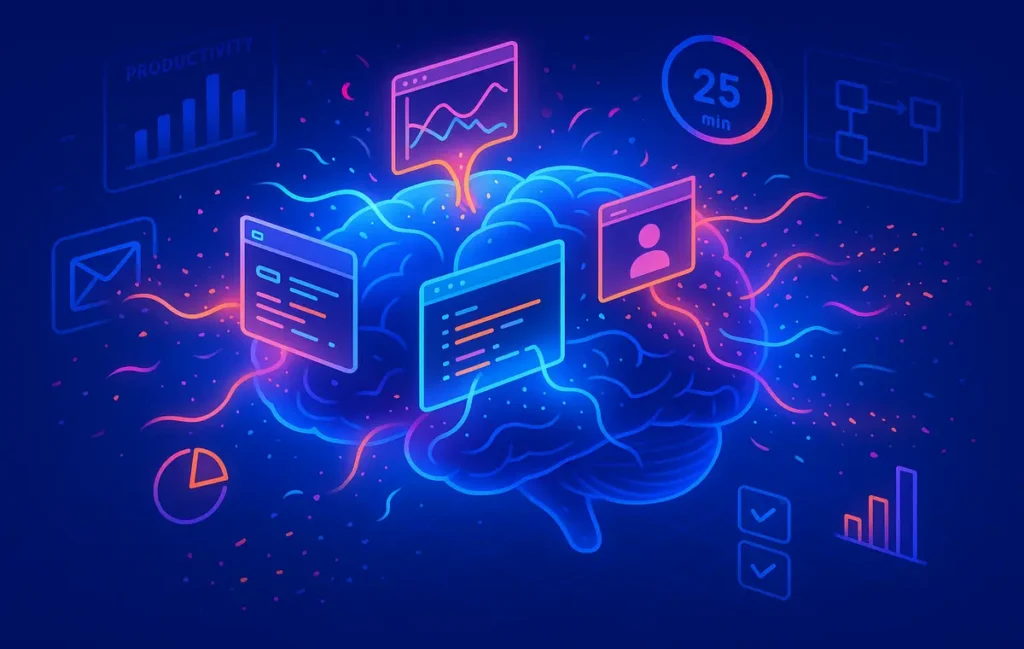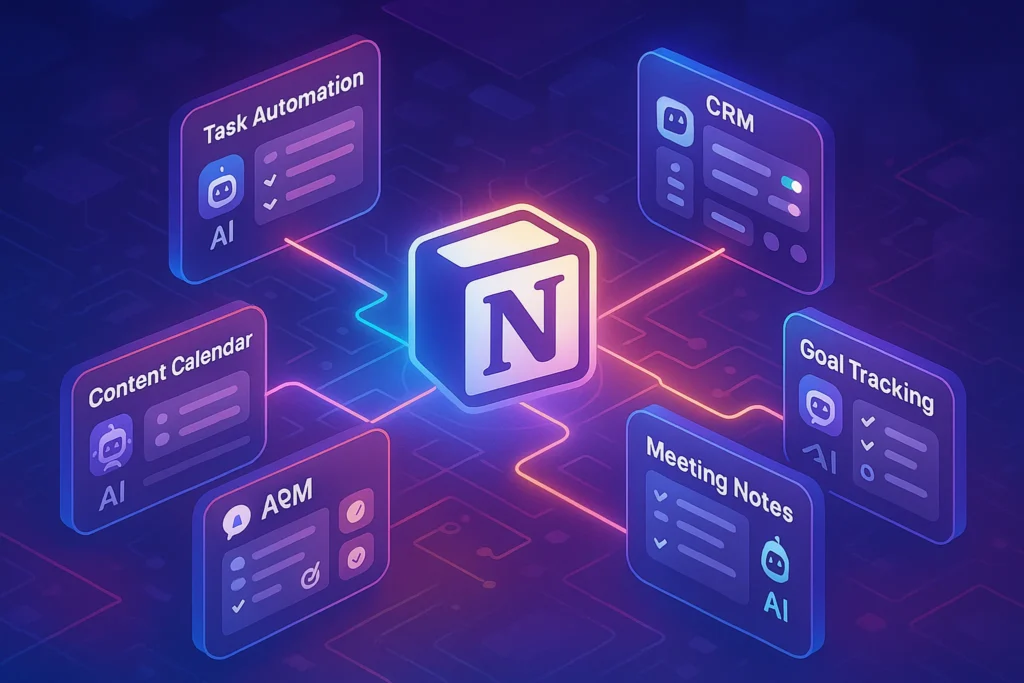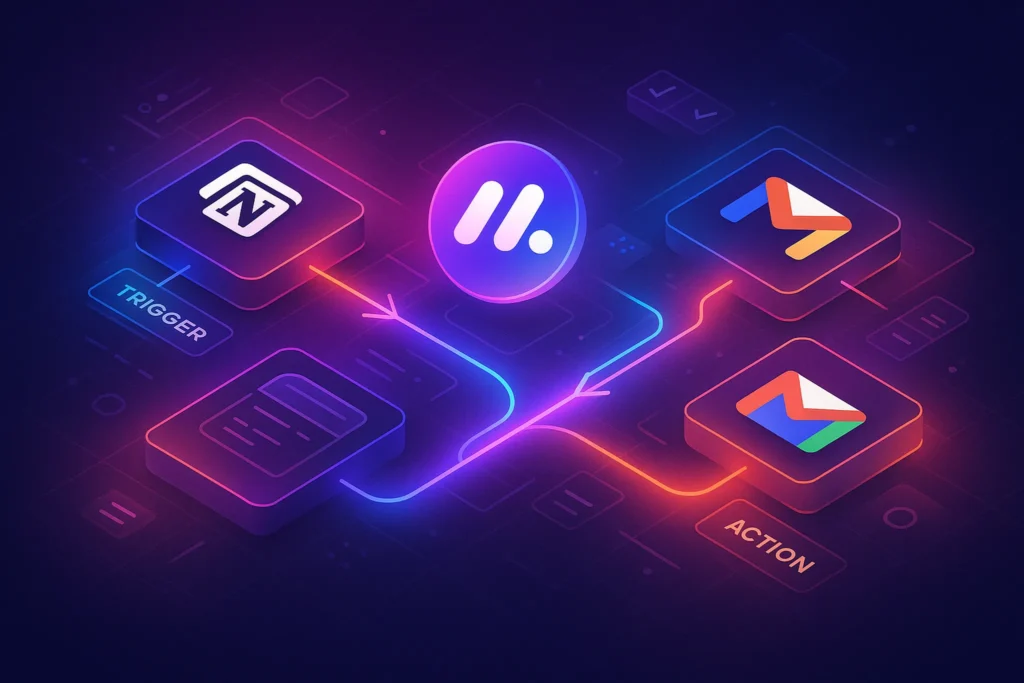🎯 Intro
Every time you jump from email to a project, from Slack to spreadsheets, your brain pays an invisible cost: the context-switching tax. It’s the silent killer of focus in modern knowledge work, where digital interruptions are constant and expectations of multitasking have become the norm.
Research in cognitive neuroscience shows that the human brain is not designed for rapid task switching. What feels like efficiency—checking messages while drafting a report—actually erodes performance. The “attention residue” left behind reduces your ability to think deeply, slowing recovery time and creating mental fatigue.
At NerdChips, we’ve explored tactics like time blocking and Pomodoro. But context-switching deserves its own spotlight. It’s not just about distraction—it’s about how the architecture of your day either compounds hidden cognitive costs or frees you to work with flow.
🔍 What is Context-Switching Tax?
Context-switching tax is the cognitive load your brain incurs when shifting between different mental tasks. Unlike simple physical multitasking (walking and listening to music), knowledge work requires executive control and working memory. Each time you switch, your brain must “unload” the rules of the previous task and “load” the new one.
Psychologists call the leftover trace “attention residue.” It means part of your mind is still preoccupied with the previous task, reducing clarity on the current one. In a workplace filled with notifications and overlapping responsibilities, this residue accumulates, leaving you drained.
This tax is especially harmful in knowledge-intensive fields—developers juggling code and meetings, marketers balancing creative ideation and analytics, or remote workers constantly jumping between Zoom and inbox. It doesn’t just cost minutes—it undermines quality, creativity, and decision-making itself.
📊 The Hidden Cost of Switching
The true cost of context-switching is often underestimated because it’s not as visible as lost time on social media. But the science is sobering.
Studies suggest it can take 15–25 minutes to fully regain concentration after a switch. If you check Slack five times in an hour, you may never achieve full focus at all. Over weeks, this leads to hours of hidden productivity lost.
The toll isn’t just time. Decision fatigue compounds with each switch. When your brain constantly shifts gears, it burns glucose faster, leaving you mentally depleted. The result is poorer judgment, shallow thinking, and errors you wouldn’t make if focused.
There’s also the emotional cost. Workers report higher stress levels and mental exhaustion when juggling multiple contexts. Remote employees, in particular, describe finishing the day feeling “busy but unproductive,” a direct consequence of fragmented attention.
Context-switching is more than a nuisance—it’s an economic drain. A study on enterprise teams showed employees interrupted frequently could lose up to 30% of effective work time each week. For companies, that translates into millions in wasted payroll.
🚀 How to Design Your Day to Minimize It
The good news: context-switching tax can be reduced with intentional design.
One proven strategy is time blocking, which involves assigning uninterrupted blocks of time to similar tasks. Instead of scattering emails throughout the day, batch them into two 30-minute windows. By grouping similar work, your brain operates in the same “mode” longer, reducing costly resets. Our Beginner’s Guide to Time Blocking explains how to set this up step by step.
Another is batch processing. For example, process Slack or email messages in scheduled sprints rather than reactively. By confining these to boundaries, you protect focus windows.
Deep work sessions, as popularized by Cal Newport, mean committing to extended periods of single-task immersion. Even 90 minutes of undisturbed focus can produce more progress than an entire distracted day.
Finally, transitions matter. Instead of rushing between contexts, use mindful breaks—three deep breaths, a quick journal entry, or a five-minute walk. Neuroscience research shows mindful transitions reduce attention residue and help reset the brain.
💡 Nerd Tip: Use the 3-task rule. Identify only three primary tasks for the day, and treat everything else as secondary. This forces prioritization and reduces unnecessary switching.
🛠️ Tools That Help
Tools alone won’t solve context-switching, but the right ones reinforce design.
Smart calendar apps with AI scheduling can cluster similar tasks automatically, protecting deep work windows. Focus apps like Freedom or Cold Turkey block distractions across devices, ensuring Slack pings or social feeds don’t creep into focus time.
Task managers with context tagging (Todoist, ClickUp) help categorize work by project, location, or energy level. When you sit down for a focus session, you see only what belongs to that mode, preventing you from bouncing between unrelated categories.
Combined with frameworks like time blocking vs Pomodoro, these tools form a digital guardrail that protects your cognitive bandwidth.
⚠️ Challenges & Solutions
Of course, reducing context-switching is easier said than done.
For those working in interrupt-heavy environments, blocking notifications during focus time is essential. A Slack status set to “heads down” paired with app-level notification blockers signals boundaries without breaking team communication.
Remote workers face unique challenges: blurred lines between home and work amplify interruptions. A dedicated workspace, even a small corner, reinforces contextual separation.
For multi-role professionals—for example, a founder juggling product, sales, and ops—the solution is role-based time blocks. Divide your day into “CEO mode,” “creator mode,” and “manager mode.” Within each, tackle only tasks aligned to that role, minimizing mental gear-shifts.
These adjustments require discipline but prevent you from carrying the full mental cost of fragmented work.
📈 ROI of Reducing Context Switching
The return on reducing context-switching is measurable and significant.
A University of California study found that minimizing interruptions improved productivity by up to 30%. That’s like reclaiming an extra day and a half of output every week without working longer hours.
Reducing switches also lowers burnout. Employees in environments with structured focus time report greater energy at the end of the day and higher job satisfaction. Companies that implemented focus-friendly practices saw reduced turnover and improved project delivery.
On an individual level, people report clearer thinking, faster completion times, and higher-quality results. Writers finish drafts faster, developers produce cleaner code, and managers make sharper strategic decisions. The compound effect isn’t just more done—it’s better work, done sustainably.
⚡ Redesign Your Day—Cut the Hidden Tax on Your Focus
Explore smart calendar apps, focus blockers, and task managers to protect deep work. Minimize context-switching and unlock your best productivity.
🔎 Historical & Neuroscience Background
The roots of context-switching tax lie deep in how the human brain is wired. Neuroscience shows that we are not built for parallel processing when it comes to cognitively demanding work. Psychologist George Miller’s famous “7±2 rule” demonstrated that working memory can only hold a limited number of items at once. When you switch from one complex task to another, you force your brain to flush its active buffer and reload a different set of mental rules.
John Sweller’s research on cognitive load theory expands on this. When mental resources are constantly diverted, learning slows down, and problem-solving quality declines. Instead of performing tasks simultaneously, the brain toggles between them, creating what feels like multitasking but is actually rapid serial switching. Each toggle incurs a penalty—time, energy, and accuracy.
This scientific grounding explains why constant context-switching feels exhausting. It’s not laziness or lack of discipline; it’s biology. By respecting these limits, we design days that align with how the brain really works.
📊 Industry Benchmarks & Case Studies
Large organizations have begun quantifying the cost of switching. Microsoft’s internal studies revealed that after a digital interruption, it takes an average of 23 minutes for an employee to return to the original task with full focus. For a team of 100 knowledge workers, that equates to hundreds of lost hours each month.
Google experimented with “meeting-free Wednesdays” for some teams. The result was a reported 20% increase in developer output because engineers could protect deep work sessions without constant pivots to meetings or chat.
Startups also see results when they design work intentionally. A SaaS company shared that by batching customer support and marketing tasks into separate windows, their small team achieved a 15% faster feature delivery cycle. These numbers prove that context-switching isn’t just theory—it directly shapes productivity and revenue.
🧩 Integration With Productivity Frameworks
Context-switching tax doesn’t exist in isolation; it intersects with major productivity systems. In David Allen’s Getting Things Done (GTD), the idea of “contexts” was introduced to reduce mental switching. By grouping tasks into categories like “phone,” “computer,” or “office,” GTD minimizes transitions.
Similarly, companies that run on OKRs (Objectives and Key Results) benefit when employees align work blocks to specific goals rather than scattering efforts across multiple roles in the same day. This strengthens focus on what matters most.
For readers of NerdChips who explored How to Set Up a Productivity System That Actually Works, integrating context-switch reduction into their system is the natural next step. Instead of just managing lists, the structure of the day itself becomes a productivity multiplier.
🏭 Team & Organizational Perspective
At the organizational level, context-switching is often amplified by culture. Teams that default to real-time communication create an environment of perpetual interruption. The solution is adopting asynchronous communication policies, where updates are logged in shared dashboards or project tools rather than interrupt-driven chats.
Some companies implement meeting-free blocks company-wide. By synchronizing deep work hours, they reduce forced context shifts caused by scheduling conflicts. Others rely on shared task boards (Asana, ClickUp, Jira) so that everyone can see progress without constantly asking for updates.
For remote teams especially, reducing switching is essential. A distributed workforce already faces fragmented attention across time zones and tools. By embedding focus norms into culture, leaders not only boost output but also prevent burnout.
🔮 Future of Work & Predictions
The future of context management will likely be shaped by AI and analytics. Smart assistants are emerging that schedule tasks with minimal switches—for example, clustering meetings by topic or aligning work based on cognitive energy peaks.
Some experimental platforms are developing context-switch alerts: if your calendar stacks unrelated tasks back-to-back, the system suggests adjustments. Similarly, workplace analytics may soon measure the tax each employee pays, providing dashboards that reveal hidden drains on attention.
We may also see the rise of “cognitive ergonomics,” where digital workspaces are designed with neuroscience in mind, much like office chairs were once redesigned for physical ergonomics. In the future, reducing context-switching won’t be optional—it will be a competitive advantage.
📈 Personal Stories & Quotes
Data matters, but so do human stories. On Reddit, one knowledge worker confessed: “I thought I was productive until I tracked my task switches. Turns out I was wasting three hours a day just shifting gears.”
Another user on X shared: “Batching emails into two sessions per day saved my sanity. Before that, I felt like I worked all day but accomplished nothing.”
These anecdotes resonate because they highlight the emotional side of switching. It’s not just about output—it’s about ending the day feeling accomplished instead of drained. And that’s why intentional design is more than a productivity hack; it’s a path to better well-being.
🛡 Practical Checklist for Readers
To turn insights into action, here’s a quick checklist you can use to start minimizing context-switching today:
-
Plan 3 core tasks each day to anchor your focus.
-
Batch emails and messages into 2 fixed windows.
-
Use focus blockers to silence notifications during deep work.
-
Design mindful transitions—a short walk, breathing, or journaling between tasks.
-
Protect deep work blocks by aligning them with your peak energy times.
Even adopting two or three of these practices can reclaim hours of focus every week.
📬 Want More Smart Productivity Tips Like This?
Join our free newsletter and get weekly insights on productivity, focus systems, and future tools—delivered straight to your inbox. No fluff. Just value-packed strategies from NerdChips.
🔐 100% privacy. No noise. Just clarity-driven tips from NerdChips.
🧠 Nerd Verdict
Context-switching tax is invisible but devastating. It robs you of clarity, time, and creativity, creating a sense of constant busyness without progress. But the solution isn’t superhuman willpower—it’s smart design. By structuring your day with blocks, batching similar tasks, using tools that guard focus, and respecting mindful transitions, you can dramatically reduce the cognitive toll.
At NerdChips, we see this as one of the defining productivity challenges of modern work. And unlike many trends, the payoff is not speculative. The science is clear: minimize switches, maximize depth. That’s how you reclaim control over your brain’s most valuable resource—attention.
❓ FAQ: Nerds Ask, We Answer
💬 Would You Bite?
Would you redesign your day if it meant reclaiming two extra hours of deep focus?
Are you willing to cut the hidden tax on your brain to unlock sustainable productivity? 👇
Crafted by NerdChips for thinkers and teams who want focus to become their ultimate advantage.



